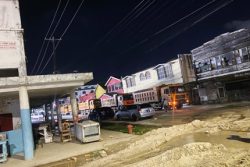Interviews and photos by Subhana Shiwmangal
Stabroek News spoke to Toshaos and a senior councillor from various villages in the hinterland about the cost of living and how it is affecting them. They were in Georgetown for the National Toshaos Conference. The following are their comments:
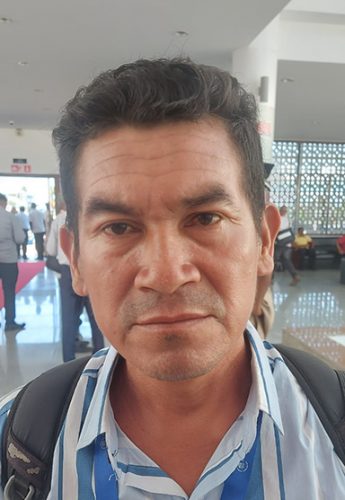
Sebastian Scipio, Toshao for Tuseneng village, Region 8: `Farmers are being affected by the cost of living since the price for foodstuff are high and the cassava farmers planted (but) the roots had rottened quickly. Also, the transportation cost villagers have to pay to traverse around the village is expensive. And, the truckers that sells food items in the village, raise their own prices on food items because of the bad roads that are filled with potholes. Another thing, the people in the village are mostly farmers and people are finding it hard to find jobs and it affects them a lot when purchasing items from the truckers because the prices are high. For instance, a 10 kg bag of sugar cost almost $3,800 now from the truck; three months ago the same bag of sugar was cheaper. Even rice gone up. Also, fish gone up, the villagers hardly getting fish. A pound of Hourie cost $700 now; a few months ago the cost was $500. I would like the government to help with smoothing the roads, I did request from the government for materials needed to full the potholes on the roads so truckers can sell their food items at a reasonable cost to villagers. Also, most farmers planted their crops but they are having difficulties with getting fertilisers and pesticide for their plants. I would like if the government can provide us with fertilisers, pesticides and seeds in order to help farmers when planting so the prices for food items can be reduced.”

Errol Charles, Toshao for Assakata village, Region 1: `The cost of living is high for villagers because food items have become expensive in and out of the village. For instance, the cost of a big bag Karibee rice out of Moruca cost $3, 000. We are buying a small bag Karibee rice from Moruca for $2,200; a few months back the cost was a $1000. Also, flour, fuel – everything gone up in the village. A gallon gasoline cost $1,600 now; three years back the cost for a gallon gasoline was $800. Even clothes expensive. The villagers have jobs, yes. Some are Community Infrastructure Improvement Programme workers, some do farming, fishing but the cost of living is really high on food items. I haven’t told the government anything as yet about rising cost of living but I think the government should raise the workers’ salary or try to see how the price can be reduced on food items since the prices are just going up every day rather than coming down. ‘

Giddel Fredericks, a senior councillor for Haimarakabra village, Region 1: `Well the rising cost of living is taking a toll on villagers right now because everything is expensive now. Food, clothing- the cost for everything gone up in the market. Even the farm products raising too. For instance, the cost for a gallon gasoline now is $1,500; a couple months back a gallon gasoline cost $1,100. This is one of the things that keeps rising but is not going down back and sometimes I study why it is that way. Food items such as plantains gone up now, a pound of plantain now cost $460; before the cost for a pound of plantain was $200. I think the government should look at the cost of living at a national level to see how they can assist the villagers with the rising cost of living.’
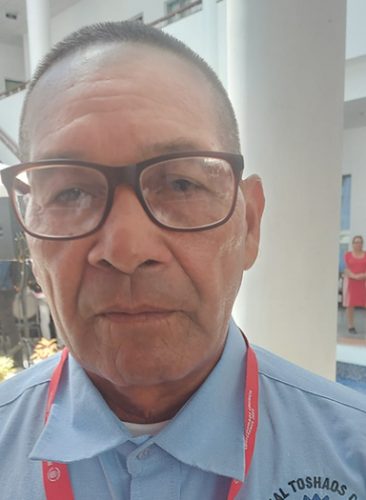
Lewis Devair, Toshao for Orealla Village, Region 6: `So far for the past few years villagers have had some difficulties with the rising cost of living because of the lack of transportation. We didn’t had the transportation that is needed where by people could go and purchase their goods and take it into the village and sell it at a cheaper price. This is so because they don’t have their own boats and engine. They depend on private boat owners for transportation. This year, things turned for the better as we have some boat owners who came into the transportation business and now, villagers can come out easily and do their purchases and return easily to the village. But, items in general is still high. Even gasoline price gone up. Also, the cost for transporting food items up the river, is very costly. As a result, the end products sold to the consumer end up being costly too. For instance, rice, powdered milk, chicken; everything gone up. The villagers grow their own chicken but still persons would do their own chicken business out on the coast but that too is costly. Other groceries such as soap, gone up. In the village, a pound of chicken cost $500 now; a few months ago the cost per pound of chicken was $350. The price for flour high, too. A pound of flour cost $125 now; before a pound of flour cost $100. Well, the government said they are looking at how the cost of living is going up so the government is trying to help us. One of the ministers that visited the village recently promised the villagers an engine since the villagers requested an engine as we need our own public transportation. So, that’s what the village is working on presently to get our own boat, our own engine so when the people travel, the transportation cost would not be that expensive on them because even the gasoline cost gone up. I was enquiring about price control on items because until now, everything is expensive for villagers and seeing that our riverine area is a far flung village, off the coast, the area doesn’t have any price control system in place to control the price items are sold. As such, vendors have their own prices and when people finished their purchases and go back the next day to purchase, the prices changed. The prices fluctuate up and down sometime. It will be good if the government can have price control on items.”
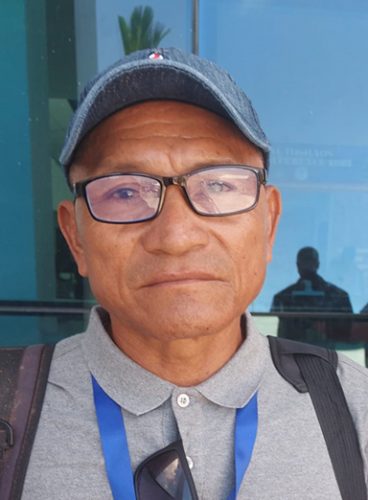
Royston Bumbury, Toshao for Four Miles village: `The cost of living is very high in the region, especially vegetables and this is affecting farmers a little but affects the persons who don’t farm, more since everything gone up. For instance, now villagers are buying about 10 bora in a bundle for $500; a couple months ago, villagers could’ve gotten more bora for $500. Even ochro expensive. Rice expensive too. A small sack of brown rice now cost $2,300; before the same sack cost $1,600 and $1,400 some places. Gasoline expensive, a gallon gasoline cost $15,000 now; before the cost was cheaper. The ministry is advising the villagers to do a food sustainability. We actually have taken that step already in terms of farming, assisting farmers to plant and grow their own produce, and others. The initiative is very good since we can plant our own food but for those who are not farming will feel the high cost, when purchasing items, versus the persons who are farming, who will not feel it much. I think the government should assist persons by supplying the seeds and pesticide. And for persons who are not farming, the government can assist them with a small stipend from the low carbon sales income to help with the cost of living.’

Michael Williams, Toshao for five villages of Annai said: `Right now because of the weather pattern, our people don’t have any cassava. Commodities have risen. Recently, the Vice President of Guyana visited Lethem to launch the Small Business Bureau and there is not enough food for my people. Because of the climate, we had a lot of rain and a lot of people’s farms were flooded. I have to tell the Vice President that as a result of this there isn’t enough commodities in the villages like on the farm. As such, everybody depending on the shops and the shop prices are high. So villages now have to push their hands in their pockets for livelihood. Food commodities such as farine, cassava bread and fish have risen because of the shortages of cassava. We used to get control prices but now there is none. It has been a steady rising of commodities. Another thing is, when people heard the villagers get cash grant from the government, they would raise the cost on items and the cost for the items never goes back down. For instance, a 100 pounds sugar cost $17,500 now that is the cheapest you can get it for. Some places has it for $20,000. A few months ago the cost for the same 100 pounds sugar was $8000. We used to buy farine for $150/$160 a pound; now we are buying farine for $400/$500 a pound. Well gasoline price is kind of stable but the fuel price is still high. Transportation cost gone up, we used to pay $4000 to go to Lethem; now we are paying $6000/$7000 to go to Lethem. Also, the cost for a large bottle of cassava casareep cost $2000 now: A few months ago, the cost was $1200/$1500. The other day the government give us small grants of a $100,000 to start small business which I found to be crazy. I preferred the government give every household the $100,000 so that they can buy groceries. Right now, the cassava is young and in the next three months or so, the people will have cassava since the cassava is young right now. So in the meantime what will they do, you know. I would like if the government can give every household the $100,000 towards groceries to help with the cost of living.”
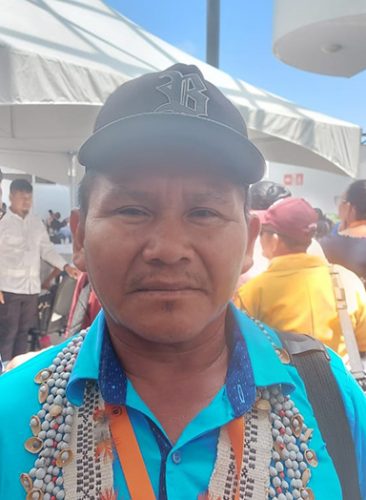
Charles Simon, Toshao for Awarewaunau, Region 9: `We have a high cost for items in our village because of the cost villagers have to pay to travel from the village to Lethem in order to do our shopping for goods, the bus fare alone for the bus to bring our goods to the village, is costly. The village do have its own businessmen that sells goods in the village but the cost they sell goods for in our village is double the price we would pay in Lethem. Another thing, it’s only Community Support Officers, Toshao and maybe pensioners that will receive money to buy groceries. Villagers are having a problem getting jobs. The farmers right now, don’t have no kind of food to live because after the floods, the cassavas haven’t mature as yet and the goods prices are high in the village. For instance, a pound of farine is $200/300 now; before the cost was $180. A pound of sugar cost $160 now; before a pound of sugar was $120. Because of the different challenges we face with growing the cassava now, cassava is scare in the villages so we only produce farine for family use now. The climate change, for example. After the floods, there has been too much sun and this is drying the cassava too much causing the root to rot. Another challenge is the bush hogs that comes and destroy the crop. We call on the government for assistance on the food side since the villagers need urgent help from the agriculture department to have the savannahs immediately plow, so we can use it. Also, we have transportation but we need money to purchase our own fuel to do our savannahs plantations. We really need help from the government in these area to help cushion the cost of living in the village.’
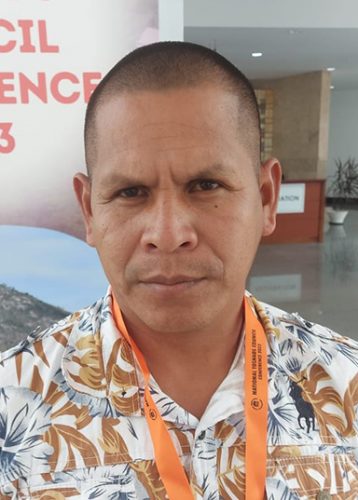
Deon Adams, Toshao for White Water village, Region 1: `The cost of living is not too high since it can reach the villagers’ earnings but the cost of living do affect the villagers a little since most villagers make their earnings by farming and logging. The cost of goods would go up sometimes when the ferry that comes from Georgetown don’t reach on time to Mabaruma, this causes the cost of living to go up, versus when the boat works every week, the price for items will drop back. Since January though, the cost for groceries and vegetables have gone up, the only items I saw that have a reasonable price now is the cassava bread. The cassava bread right now in the village is $12,000 a hamper; last year the cost was $6,000. We don’t really manufacture farine on a large scale, we only produce it on a small scale. A pound a farine now is $500; A few months ago the cost was $300. I saw that fuel price gone up in the village. A gallon gasoline cost $1,800 now; a few months ago the cost was $1,200 a gallon. I would recommend that the government create more jobs in the village, which I always raise with the government because if the villagers get more jobs, such as: more teachers, more health workers, it would ease down the cost of living more. Well, I must commend the part-time jobs we are having in the village since it’s helping the villagers a lot but we still need more jobs in the village.’
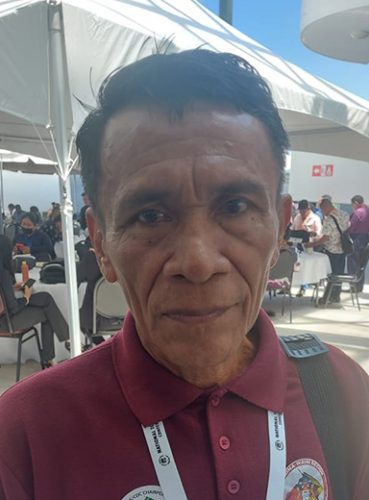
Carl Norton, Toshao for Unity Grant, Region 1: `Presently now the cost of living is high because in the village, we don’t have place to purchase groceries and other items. Instead we would have to travel from Unity Grant to Moruca which takes about a day for villagers to shop, especially when the villages go to shop groceries in a small quantity, and then they will go back to the village. To do this, they will have to earn plenty of money before they go to purchase groceries and return to the village, because we travel by boat and the fare is costly and, so is the items. The transportation cost gone up because of the high fuel price. A gallon gasoline is $1,600 now; a few months ago the cost per gallon gasoline was $10,000/$11,000. Another thing is there is no permanent jobs for the people, I must thank the government for the employment of six Community Support Officers in the village and the three part-time workers as this helped the village to get a little credit. People do plant but only small gardens. Well, presently we are getting a 100 acres of farmland by the government to plant and maybe in the future the village will farm on a large scale. As of right now, food items are high for the village, for example, a pound of plantain cost $120; a few months ago a pound of plantain was $80/$75. The government should assist us in empoldering the land so we can have better access to farming and more jobs. Also, in the future for the government to help us to get the produce to sell so the people can benefit.’

Apollos Issacs, Toshao for Karaudarnau village, Region 9 said: `We have faced a lot of challenges with the cost of living because of the food prices. The main thing I want to raise is the problem the villagers are getting with the feeding programme. The programme pays the staff by a plate of food. The staff receive payment of $250 per plate of food. We are currently working on an increase to have the $250 per plate of food raise to $300 per plate for the staff’s payment because food items are more expensive now, due to the high cost of living. The ingredients to make salads for the pupils gone up, the cost of greens, such as: ochro, bora and others gone up. We currently have over 200 pupils to feed. Sugar would normally cost $260 a kg; now the cost is $500/$600 a kg of sugar. A pound of beef is $300/$400 at some places; before in the village a pound of beef would be for $280/$260. The transportation cost is costly now because of the high gasoline cost. A gallon of gasoline cost $2000 now; before the cost per gallon of gasoline was $1,200. The government should improve the rate staff are being paid per plate of food, in order to give the kids a proper meal and for the staff to feel more comfortable. Right now they are suffering. We have to try to work on solutions since we have identified the problems because it’s not just foodstuff gone up, even the house materials gone up. If we get this improve, we will have a comfortable staff. I think the government should raise all the sectors payments in terms of the public servants, such as: teachers and so on. Everything will be good once persons in the village can afford to buy food items.’




